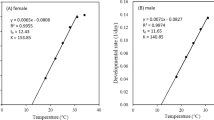Abstract
Comparative biological data on five European cultures ofAnaphes flavipes [Hymenoptera: Mymaridae], an egg parasite ofOulema melanopus [Coleoptera: Chrysomelidae], indicated differences in developmental rates as those individuals representing cultures from the southernmost latitudes developed the slowest at 21°C, while those from the northernmost latitudes developed the fastest at this temperature. At 15.6°C, however, the parasites from the southern latitudes developed faster than those from the northern latitudes. Variations in other biological attributes, including longevity and fecundity, were not statistically significant.
Résumé
Des données biologiques sur 5 souches européennes d'Anaphes flavipes (Foerster), parasites d'œuf d'Oulema melanopus (L.), sont considérées comparativement. La longévité de 676 femelles en laboratoire fut de 31,6±1,9 heures, et 777 femelles parasitèrent chacune une moyenne de 11,9±1,9 œufs hôtes. Le taux de parasitisme fut le plus élevé durant les premières 24 heures d'exposition et approcha d'un œuf par 2 heures. Ce taux diminua jusqu'à environ 1 œuf par 10 heures d'exposition entre 24 et 62 heures. A ce point de vue, le biotype de Rome (Italie) fut le moins actif alors que celui de Lerida (Espagne) fut le plus actif. Seuls des individus du biotype de Rome vécurent plus longtemps que 72 heures. Ces variations ne sont pas significatives statistiquement.
En chambres climatisées ces biotypes des 2 latitudes les plus au Sud, Rome et Lerida, se développèrent le plus lentement à 21°C, tandis que ceux des 2 latitudes le plus au Nord, Nanterre (France) et Zemun (Yougoslavie) se développèrent le plus rapidement à cette température. A 15,6°C, les parasites de Rome, Lerida et Tours (France) se développèrent plus rapidement que ceux de Nanterre, Zemun et Cahors (France).
Similar content being viewed by others
References
Anderson, R. C. &Paschke, J. D. — 1968. The biology and ecology ofAnaphes flavipes [Hymenoptera: Mymaridae], an exotic egg parasite of the cereal leaf beetle. —Ann. ent. Soc. Amer.,61, 1–5.
Anonymous. — 1962. Cereal leaf beetle (Oulema melanopa L.). —Plant Pest Cont. Div., Agr. Res. Serv. USDA., 3 pp.
Bakkendorf, O. — 1964. Notes onPatasson Walker,Anaphes Hal., andCleruchus detritus n. sp. [Hymenoptera: Mymaridae]. —Entomophaga,9, 3–7.
Castro, T. R., Ruppel, R. F. &Gomulinski, M. S. — 1965. Natural history of the cereal leaf beetle in Michigan. —Quart. Bull. Mich. agr. exp. Sta.,47, 623–653.
Venturi, F. — 1942.Lema melanopa L. [Coleoptera: Chrysomelidae]. —Redia,28, 11–88.
Author information
Authors and Affiliations
Additional information
This research was supported in part by cooperative agreement no. 12-14-100-8428 (33), Insect Identification and Parasite Introduction Research Branch, Entomology Research Division, ARS, United States Department of Agriculture.
Journal Paper 3846 of the Purdue University Agricultural Experiment Station.
Rights and permissions
About this article
Cite this article
Anderson, R.C., Paschke, J.D. A biological evaluation of five European cultures ofAnaphes flavipes [Hymenoptera: mymaridae], an egg parasite ofOulema melanopus [Coleoptera: chrysomelidae]. Entomophaga 15, 107–120 (1970). https://doi.org/10.1007/BF02371628
Issue Date:
DOI: https://doi.org/10.1007/BF02371628




